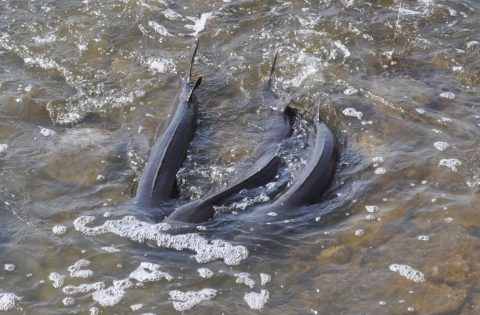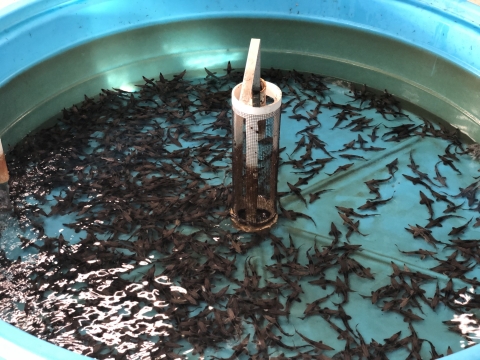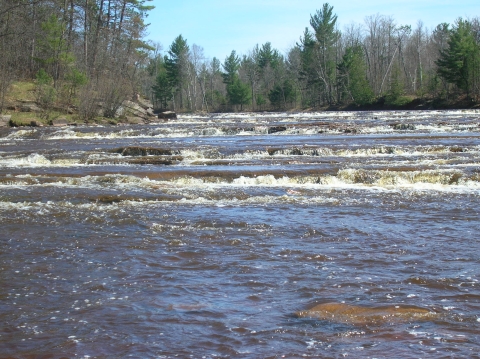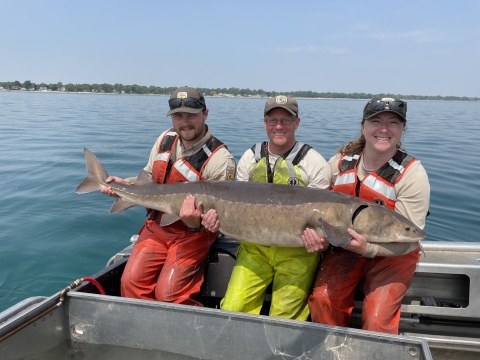For one of North America’s most wide-ranging species, it takes an equally broad approach to restoration to create a comeback. Across 24 states and along with five provinces in Canada, we at the U.S. Fish and Wildlife Service join a network of partners in bringing a flagship fishery back to health in our Great Lakes and mighty rivers.
The decimation of lake sturgeon at the turn of the 20th century is akin to the mass destruction of the American bison. American Indian Tribes and First Nations lived in harmony with both animals since time immemorial, holding them uniquely sacred and relying on them for their survival. Both species were once so broadly dispersed, plentiful and captivating that their near demise in a matter of decades is incomprehensible.
Yet, after 150 million years of life on Earth, overharvest and killing en masse as a nuisance fish nearly wiped out this prehistoric creature. Miraculously, the legendary lake sturgeon, one of the largest and longest-living freshwater fish in the world, prevailed against the destruction and now inspires a shared reverence among partners working persistently on its behalf.
Progress is showing in places like the Red River between Minnesota and North Dakota, part of the Hudson Bay basin, where lake sturgeon were completely destroyed and are now reestablished and spawning. We have renewed hope along the St. Clair and Detroit Rivers, where the largest population in the Great Lakes is consistently spawning in restored habitats. We celebrate the lake sturgeon’s resurgence on the Manistee River in Michigan, where the Little River Band of Ottawa Indians pioneered streamside rearing 20 years ago, helping to restore the community’s relationship with the clan animal they call nmé.
When we work to reverse the damage, lake sturgeon respond.
From ruin to renewal
Still one of the widest ranging North American fisheries, lake sturgeon were once abundant across the eastern and central United States and Canada, stretching all the way south to the Mobile River basin and throughout the Great Lakes, Hudson Bay and Mississippi River basins.
While careful harvest regulations were put in place several decades ago, access to healthy habitat continues to present the biggest challenge for lake sturgeon restoration. Historically, construction of dams, river channelization and dredging, pollution, farming and logging all contributed to blocked migration pathways and degraded habitat. Restoring enough access to healthy spawning habitat is particularly important to the species’ continued survival.
Species that reproduce early and often have more overall resilience when they face threats. Lake sturgeon do not have these advantages. It can take 10-30 years before they reach spawning age, and a lot can happen in the early years when they are most vulnerable. Lake sturgeon also spawn only intermittently, not every year. What’s more, they range widely, migrating sometimes hundreds of miles from the tributaries where they were born out into large rivers and lakes and back again to spawn. Of those that survive to maturity, many must navigate through an obstacle course on these back-and-forth journeys.
For our agency, working alongside American Indian Tribes and First Nations, states, provinces and countless conservation groups and community partners, these environmental and life cycle challenges guide lake sturgeon restoration today. Partners focus on three main areas:
- Raising lake sturgeon in hatcheries for reintroduction in historic areas of their range and stocking to supplement natural reproduction for existing populations,
- Tagging and tracking fish as one way to assess progress and refine our approaches and
- Restoring habitat access, quality and quantity through dam removal, construction of fishways, recreating historic habitat conditions and cleanup in lakes and rivers.
Since it takes so long for lake sturgeon to reach adulthood, we are finally seeing how passage of the Clean Water Act and collective efforts begun decades ago are leading to growing lake sturgeon populations, expanding populations in new areas of the historic range and increasing spawning success. Following this trajectory will ultimately create healthy, self-sustaining populations in more areas. Full restoration means lake sturgeon will no longer need continued stocking for population growth and stability—they will be able to keep reproducing, generation after generation, all on their own.
Hatcheries at the heart of it
Genoa National Fish Hatchery in Wisconsin is at the heart of lake sturgeon restoration. One of the premier federal hatcheries in the nation, Genoa has a lead role in rearing lake sturgeon, raising more than 60,000 fingerlings per year and providing eggs and fry for stocking and research across the species’ broad range.
Sometimes Genoa’s expertise comes into play off-site for streamside fertilization efforts, too. This is no small feat for fish that can be roughly the same size as their human helpers. On the Wisconsin River, for example, biologists from Genoa and the Wisconsin Department of Natural Resources use dip nets to capture spawn-ready adults, carefully expel milt from the males and eggs from the females, combine them on site and release the fish back into the river. Fertilized eggs are then transported to both Genoa and Neosho National Fish Hatchery in Missouri for incubation, rearing and future stocking. Once they reach target size, Genoa’s are stocked at multiple locations and Neosho’s are provided to the Missouri Department of Conservation for release into the Mississippi River.
Genoa’s reach extends into the Saginaw River in Michigan and the Maumee River in Ohio as well, where thousands of young lake sturgeon are released each year to restore populations in Lakes Huron and Erie. Meanwhile, the Iron River National Fish Hatchery in Wisconsin and Ashland Fish and Wildlife Conservation Office are working with partners to restore lake sturgeon on the Ontonagon River in Michigan and St. Louis River in Minnesota, tributaries of Lake Superior. In some areas this involves collecting larval sturgeon and in others collecting milt and eggs from spawning adults.
Rearing and stocking methods depend on restoration goals for different populations and watersheds. Another method is streamside rearing trailers, basically mobile mini versions of hatchery facilities. These retrofitted trailers are used in several areas throughout the Great Lakes basin. River water is pumped into the trailers so fish can acclimate for several months after they are brought in during their larval state. Miraculously, the chemistry of their home river imprints so they know how to find the same area decades later when spawning time comes.
One advantage of rearing young fish is it gives us the opportunity to tag them for further research. Passive Integrated Transponders, or PIT tags the size of a grain of rice, are implanted after just a couple months of growth. Across the lake sturgeon’s wide range, tagging and tracking—or telemetry—give biologists crucial information on the abundance, distribution, age, growth and health of different populations, all of which are used to continually refine restoration approaches.
It’s a long story
Every fish has a story, and telemetry provides the narration. Far away from the hands-on restoration activities, biologists scour through hordes of data collected from various telemetry efforts, analyzing all kinds of lake sturgeon life cycle information that ultimately measures and guides our progress.
Each PIT tag has a unique barcode, responding to strategically placed scanners, helping biologists understand the movement of individual fish. This is especially important for determining whether and how many released sturgeon survive and return to their river of origin to spawn.
Efforts such as those on the Saginaw and Maumee Rivers rely on an additional, different kind of tagging operation. Since 2010, the binational Great Lakes Acoustic Telemetry Observation System involves hundreds of underwater stationary receivers that collect data from acoustic tags implanted inside juvenile and adult fish, promoting much broader data sharing among partners.
Acoustic tags transmit a signal so biologists are able to collect specific data about where fish go and when. This informs decisions about the most important habitats to restore and protect, best places to reintroduce fish and migration barriers to focus on removing.
Going with the flow
As much as they rely on big waters in adulthood, lake sturgeon also need clean, swift-flowing rivers with gravelly bottoms for their early life and spawning. For this reason, barriers to their wide-ranging migration are the most significant factor affecting the species.
A prime example is the plight of the Menominee River lake sturgeon population—the largest in Lake Michigan. Historically, these sturgeon were able to migrate upstream from Green Bay to spawn in this river along the border of Wisconsin and Michigan’s Upper Peninsula. But construction of the Menominee Dam and others in the 1920s made this impossible—until almost a hundred years later.
The Menominee River Fish Passage Project in northern Wisconsin, completed in 2015, was one of the first and largest fish guidance and bypass structures for lake sturgeon in the Great Lakes. Two dams on the Menominee were retrofitted to allow spawning sturgeon to travel up- and downstream past the dams to access their spawning habitat, restoring some 2,000 acres along their migration path.
Another example of progress is the removal of the Brecksville Dam on Ohio’s Cuyahoga River in 2020, opening up a 45-mile stretch from Lake Erie to the Ohio Edison Dam near Akron. Along with improvements to water quality, this helps bring another historically important spawning area into consideration for future lake sturgeon reintroduction. Partners are working on a sophisticated habitat mapping project to inform these kinds of decisions throughout the Great Lakes.
In cases where dam removal or retrofitting is not feasible, dam operations may be modified to regulate the release of water, with significant benefits to certain lake sturgeon populations. Spawning habitat can often be found below dams, making it important for dams to release enough water to keep habitat from drying up but not too much that it creates turbidity and excessive flow.
Healthy habitat is where it’s at
All the efforts to stock and track fish and improve fish passage fish passage
Fish passage is the ability of fish or other aquatic species to move freely throughout their life to find food, reproduce, and complete their natural migration cycles. Millions of barriers to fish passage across the country are fragmenting habitat and leading to species declines. The U.S. Fish and Wildlife Service's National Fish Passage Program is working to reconnect watersheds to benefit both wildlife and people.
Learn more about fish passage can only succeed in restoring lake sturgeon if the species also has enough healthy habitat to meet its life cycle needs.
Restoring reef habitat is a key part of our work for the 33,000 lake sturgeon making up the largest remaining population in the Great Lakes. Historically, dredging destroyed much of the prime spawning habitat along the 100-mile corridor connecting Lakes Huron and Erie. In recent years, partners recreated 20 acres of reef habitat and we are now consistently finding eggs year after year.
In addition, ongoing environmental cleanup will always be a main component of lake sturgeon restoration. Our agency’s leading expertise in environmental contamination supports a variety of efforts to mitigate harm to fish and wildlife from pollutants in our waterways and elsewhere.
Our partnership with the U.S. Environmental Protection Agency and others focusing on Areas of Concern is a notable example. Areas of Concern are “toxic hotspots” dotting the shorelines of the Great Lakes where beneficial uses have been significantly impaired. Their designation back in the 1980s was a starting point for large-scale environmental cleanup throughout the Great Lakes, targeting areas where it was needed most.
Forty-three Areas of Concern were originally established and nine have been delisted. Out of the original total of 255 beneficial use impairments identified for all Areas of Concern, restoration targets for 122 of them have been reached. Every increment of progress brings us closer to reaching our restoration goals for lake sturgeon and so many other natural wonders of the Great Lakes.









